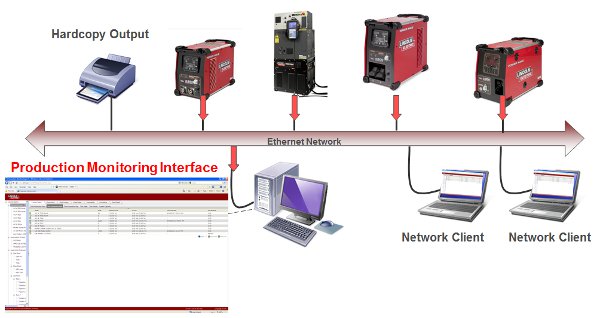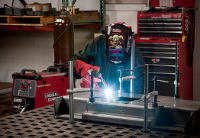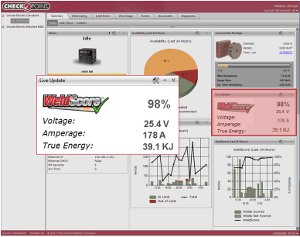Bruce Chantry, Equipment Portfolio Manager, The Lincoln Electric Company
In a competitive global economy, efficiency reigns supreme on the shop floor, especially when it comes to overall equipment effectiveness.
With this in mind, well-run fabrication shops have become increasingly vigilant about keeping costs under control while striving to reach higher levels of productivity and quality in all aspects of the production cycle. Welding operations are no exception.

Any welding process improvement demands the ability to benchmark and measure successes. In this post-recession manufacturing environment, people want to drive productivity up without increasing costs. And while some turn to such tools as automation and other methods that streamline the actual process, simple tools that allow evaluation and analysis of productivity and throughput can have an immense impact on a company's bottom line.
In fact, the welding industry has access to monitoring tools that enable any networked welding power source to transmit its own weld performance data. These systems can track metrics and provide analysis down to the level of a single weld performed by a particular operator on a specific welder during a certain shift, so as to establish productivity benchmarks, support, troubleshooting capability, and more.
In the past decade or so, these solutions have been evolving to help fab shops and manufacturers develop custom tracking solutions based on their needs and core technologies in a way that delivers a detailed view into the welding production environment.
While the earliest versions of these programs, introduced at the end of the 1990s, ran on PCs linked to specific power sources and had no remote tracking capabilities, some of today's systems have expanded beyond the limiting desktop environment and automatically move data into the 'cloud.' This makes the concept of around-the-clock production monitoring from anywhere on the globe on almost any device, whether it be a laptop computer, a smartphone or an iPad® or other tablet, a functional reality.
A Monitoring Evolution
Back in the 1990s, welding shops sought a method for simple data collection that would give them a detailed view into the production environment, providing such features as production and productivity metrics, weld record archives, welding procedure limits, downtime analysis, traceability, and even email alerts. They wanted something more than an out-of-the-box solution. They wanted customized production monitoring.
Production monitoring allows users at any level of an organization to view pertinent live information about each welder and analyze performance at a highly granular level. These systems also help organizations track preventive maintenance activities and red flag welding-related issues on any station in the production line, allowing engineers to prevent problems before they occur.
In the early days, such systems required local installation of a data collection utility on multiple desktop computers, all of which had to be linked to the welders at the facility. The staff then had to learn the new software in order to keep things running. This software also routinely had to be maintained and upgraded on each particular desktop computer tied into the welders. The system was limiting and data could be tracked only at each particular location. Big picture monitoring was not practically feasible.
For example, here at Lincoln Electric, we have a manufacturing facility in Cleveland. We also have one in Reno, NV. Historically, if we had installed a production monitoring system in Cleveland, we also would have had to install the system in Reno. And, in general, those of us in Cleveland would be able to see only the data from our welders here, while those in Reno could see only their welders' data. The information would run only on an individualized server at each particular location. It was limiting for senior operation managers seeking a comprehensive operational view.
Upgrades to these programs over the years expanded the capabilities, and by 2008, they allowed a single computer, vs. multiple workstations, to serve as a data collection server that users could access anywhere using a web browser through a VPN (Virtual Private Network) or an intranet. This provided flexibility within an organization, as multiple computers were not needed to run the software. It also allowed users who wanted to monitor productivity from the road at any of the company's locations to simply login to the company's VPN from any computer and gather needed information. (Shown below, single plant networked solution.)

While production monitoring solutions initially were designed to focus solely on production metrics, user demands for record retention and other quality assessment support grew and started to expand the functionality of these systems.
The monitoring technologies themselves have continued to evolve to include a focus on quality metrics. Quality tracking now is a hallmark of any good production monitoring system. New tools can reliably evaluate welds created at each station and, while not meant to replace actual quality assurance testing methods, provide a benchmark that reflects a strong probability that the part is going to be good or not.
But that hasn't been the only marked evolution in these systems over the past five years. As larger companies with facilities in multiple locations embraced technology and the widespread means of mobile communications grew, users started to demand something even more user friendly, enabling them to access data not only locally, but also globally, on the fly from the road or in the factory at the welding station, from any device without relying on the company's own computer servers and intranet access.
Taking It to the Cloud
Cloud computing has changed all that. Rather than having the production monitoring solution hosted on a server at a company location, the latest evolution of such systems moves to the cloud, where all of the data is uploaded to a central server that provides a discrete database for each customer. Production monitoring in the cloud delivers a permanent connection where data routinely flows from a company's welding power sources up to a secure data center and down to any device – via a common Internet browser on a desktop PC or a laptop, or via mobile apps on a smartphone or a tablet. It really is that simple.

Cloud-based production monitoring provides a huge advantage over the previous VPN platform, especially for companies with multiple locations, by providing a simple way to accumulate data from these locations into an easily accessible central database that can be accessed from anywhere.
Mobile-ready apps for handheld devices further simplify information gathering and review. These dedicated apps, which run through the cloud, provide only the information users want to see at their fingertips. While it's unlikely users will want to attempt to create a detailed report on an iPhone®, it is likely that a line manager could want to view the output of a specific machine to troubleshoot issues while in the shop at the workstation, or after hours when he's off site. Through a mobile app, he can get the pertinent information he needs without being tethered to the desktop.
Monitoring from the cloud also eliminates the need to invest IT manpower and equipment because on-site servers no longer are needed. No onsite software installation is required. Software maintenance and upgrades are handled automatically at the cloud server. These are now issues of the past for the fabricator.
Simply connect the welder via Ethernet and login with a unique login and a secure password. Following setup, users can just login and start tracking welding performance data on any welder in the system, all of which are identified by their unique serial number. It's basically plug and play. All you need is an Internet connection.
Once online, the welding power source initiates communications with the server, sending data packets at periodic intervals to the cloud database. Thanks to serial number tracking, all welders in a facility, or even company-wide at multiple locations, can be accounted for in the cloud. And all of this is done securely through encryption, user authentication, and other security features.
User-Targeted Data
The concept of production monitoring in the cloud is no different than web-based email, such as Gmail®, or account services websites from financial institutions, retailers, and other websites. Just as you log into your bank account, PayPal® or credit card account on a PC or a mobile device, you can use your secure user name and password to access pertinent data at any time of the day.
Once logged in, users can customize the system's interface to suit their own requirements, mirroring the system to the shop floor layout in one or many locations. These systems also can provide different layers of role-based access and data dissemination for any level of user.

For example, senior management may want to have only the "50,000-foot view," for asset utilization purposes, while production managers and supervisors may focus more closely on such things as shift statistics, daily production statistics, and other metrics for analysis and quick decision making. Production monitoring solutions can assist production level management in strategically identifying such issues as persistent bottlenecks and can help them use that information to devise long-term solutions from a production standpoint.
At the welding engineer and supervisor level, data reviewed typically focuses on weld quality. Production monitoring can help personnel in these positions to track the day, time, wire type and usage, how much weld metal was used, the wire feed speed and deposition rates – to name only a few parameters. In short, it can provide all of the information about a weld that any fabrication role would need. And it captures it for every weld on every machine connected to the system.
The system even can track welding wire consumable usage and changeouts. The consumable type and package size for each welder can be set so the level of wire being consumed can be measured digitally. The monitoring system then will alert a designated individual or individuals, via email, when the wire supply is low.
Even those involved in field welding operations now have the option for detailed tracking, thanks to the cloud. In the past, wiring a network to a line of welders on a construction site or an Alaskan pipeline project wasn't all that simple. With cloud computing, all you need is access to the Internet, through a low cost and readily available mobile hot spot device like a MiFi® or others.
Reporting Workhorse for the Mobile World
The key difference in these newest systems, beyond the cloud functionality, is traceability – which can be accessed in full reporting from a PC or in abbreviated form from a mobile device.
The latest solutions offer traceability reporting, a key consideration for those fabricators who must, in turn, hold records for customer review on welding consumable certifications, maintain records for quality initiatives, and other similar activities. Up to three user-determined fields can be tracked – operator ID, part ID, and consumable – in short, who did the weld, on what part, and with which welding wire consumable spool or package. All of this can be viewed easily on mobile devices or downloaded for record retention.
Regardless of the way a shop decides to use today's cloud-based welding production monitoring systems, it's a necessary tracking and reporting tool for today's competitively lean manufacturing environment. From helping to track flow manufacturing and minimizing material movement to examining equipment or operator performance, these monitoring solutions have moved beyond basic production tracking and metrics to detailed analytics and customized information for all levels of an organization. The centrally located, reliable database helps maintain ongoing records retention by capturing pertinent audit trail data.
Cloud-based production monitoring enables shops to maintain a pulse on welding operations and equipment with critical alerts, live production visibility, and predictive analysis with a secure, global view from any or all facilities – without the investment in expensive and complex IT equipment or support. In the end, the data captured by these systems will aid in a company's ISO, Six Sigma, statistical process control (SPC), quality cost delivery (QCD), overall effectiveness (OEE), and lean manufacturing efforts – from the main office or from the road, 24 hours a day, 7 days a week, 365 days a year.
Lincoln Electric has just introduced its third generation production monitoring software package, called CheckPoint™.





